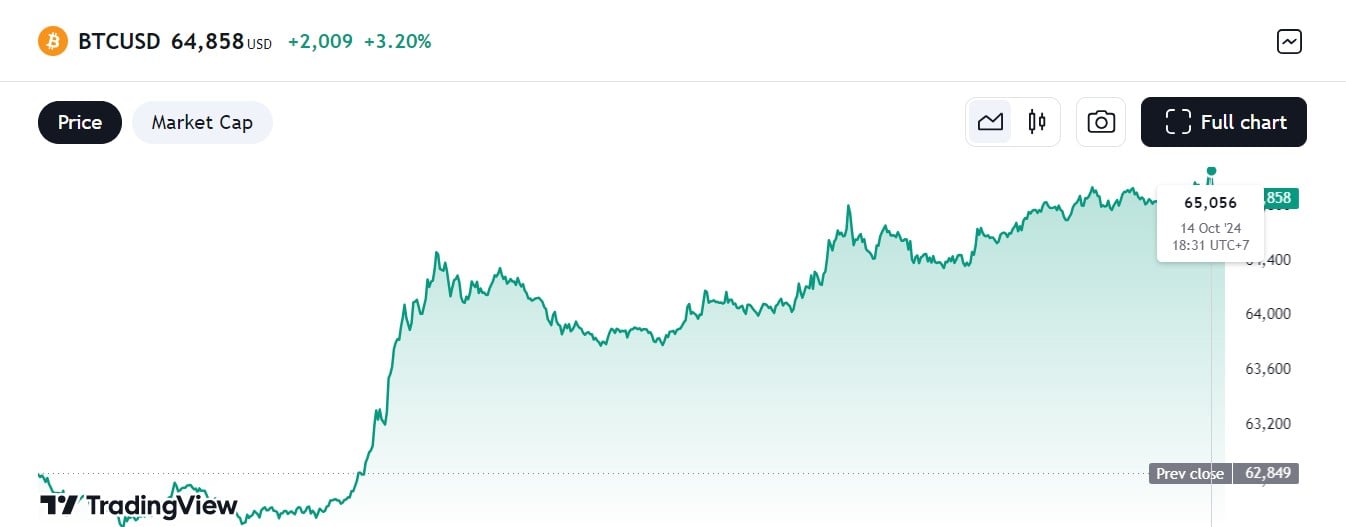Bitcoin breaks $65,000 level, altcoins eye “up-only” season
The crypto market cap exceeds $2.3 trillion as Bitcoin and altcoins gain.

Key Takeaways
- Bitcoin broke the $65,000 mark, reflecting a robust uptrend influenced by global economic factors.
- Major gains in Solana-based memecoins signal a broader altcoin market rally.
Share this article
The price of Bitcoin surged past $65,000 on Monday after breaking through the $64,000 mark and extending its rally to $64,800, according to data from TradingView. At press time, BTC is trading at around $64,900, around 11% away from the all-time high of $73,000 set in March this year.

As bulls take charge, the crypto market cap tops $2.3 trillion, up over 1% in the last 24 hours, per CoinGecko. Altcoins are experiencing a broad-based rally, hinting at the possibility of a sustained upward market trend.
Solana-based memecoins are in the spotlight with top gainers being Book of Meme (BOME), Slerf (SLERF), Billy (BILLY), and GME (GME). In the past 24 hours, BILLY and BOME surged by approximately 16% each, SLERF jumped 20%, and GME rallied by 27%.
Sui (SUI) has also made headlines since it reached a new all-time high of $2.35 over the weekend. With its market cap standing at around $6.1 billion, SUI now joins the top 20 crypto assets, surpassing Near (NEAR), Polkadot (DOT), and Uniswap (UNI).
According to a recent statement by crypto analyst Moustache, the Altcoin Season Index is forming a bullish Inverse Head and Shoulders pattern. This pattern, which has not been observed in 3.5 years, is often considered a strong signal of an impending “up-only” season for altcoins.
Altcoin Season Index has been forming one of the most bullish patterns for 3.5 years: Inverse Head and Shoulders.
Up only season is near IMO.
The pain we have had to go through in recent years will soon vanish into thin air.
Wish everyone the best this journey.🩵 pic.twitter.com/H4mk5ISpBJ
— 𝕄𝕠𝕦𝕤𝕥𝕒𝕔ⓗ𝕖 🧲 (@el_crypto_prof) October 11, 2024
Bitcoin eyes higher levels with China’s economic stimulus and US presidential election
Bitcoin’s price recently fell below $60,000 in the wake of US inflation data that was hotter than expected. Although the inflation rate did not meet expectations, it was still trending downward.
Last week’s dip below $60,000 is now seen as an outlier as Bitcoin gains momentum. The resurgence comes amid a Chinese stock market rally, influenced by China’s recent economic stimulus measures.
In an effort to revive the country’s economy, China’s Finance Minister Lan Fo’an announced plans for a fiscal stimulus package, but the exact amount of the package was not disclosed. In response to the stimulus, the Shanghai Composite Index rose 2.12%.
“A key driver of this momentum appears to be China’s recently announced stimulus package, which has supported market sentiment,” analyst Min Jung from Presto Research noted.
Augustine Fan, Head of Analysis at SOFA.org, commented:
“Bitcoin prices have climbed above $64,000 as Chinese stocks rebounded from weekend disappointments, fueling a ‘buy everything’ sentiment in the markets.
Apart from China’s stimulus measures, the upcoming US presidential election, which is typically associated with heightened market activities, could also serve as a positive catalyst for Bitcoin’s price action.
Steven Lubka, head of private clients and family offices at Swan Bitcoin, stated that Bitcoin could hit $100,000 soon no matter who is in the office.
“Do I think we’ll be in the six figures by 2025? Almost certainly. Do I think we’ll be in the six figures regardless of who wins? Almost certainly,” said Lubka.
Former President Donald Trump’s vocal support for Bitcoin and the crypto industry has led some to speculate that his potential re-election could benefit Bitcoin and the broader crypto market. His recent engagements with the crypto community and promises to support the industry have generated optimism among investors.
Despite not expressing strong support for the industry, Trump’s rival, Vice President Kamala Harris, vows to foster innovation by promoting AI, digital assets, and investor protection.
